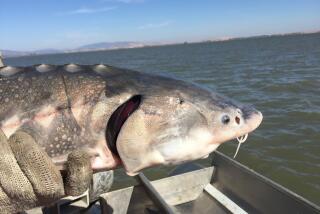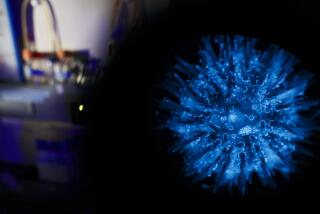Genetically engineered salmon moves closer to FDA approval
After more than a decade in regulatory limbo, genetically engineered Atlantic salmon that grow faster than their naturally born counterparts moved closer to American plates, with the publication Friday of a government report that found the fish wouldn’t hurt the environment and would be safe to eat.
The draft report, released by the Food and Drug Administration after months of unexplained delay, was greeted with cheers by members of the biotech community and anger by opponents of genetically modified foods, who commonly refer to the AquAdvantage salmon as a “Frankenfish.”
Two years ago, the FDA tentatively ruled that the salmon could safely be consumed by humans and that the fish would not harm wild species. The current report advances the process.
A 60-day period of public comment on the 158-page environmental assessment and its conclusions now follows before the FDA will decide whether to give the salmon its blessing or take some other action. There is no timeline on when that next step may happen, said FDA spokeswoman Shelly Burgess.
“I have a smile on my face — it certainly looks good for the fish moving forward,” said David Edwards, director of animal biotechnology for the Biotechnology Industry Organization in Washington. “It shows that the administration is willing to move forward on these technologies and allow the U.S. to be the leader that we should be.”
AquAdvantage salmon grows twice as fast as conventional salmon because a growth hormone gene derived from the chinook variety has been spliced into its DNA. If approved, it would be the first genetically modified animal intended for food use to pass that milestone in the United States. Edwards and others said it would invigorate the field of animal biotechnology, which is currently so moribund in the U.S. that industry investment is near-nonexistent; scientists have stopped training students in the craft, and researchers have shut down their projects or moved them overseas.
But the FDA’s actions — and the timing of its announcement, on the eve of a long holiday weekend — drew outrage from consumer advocacy groups who are not convinced that the fish is environmentally benign nor that it’s safe to eat. More than 400,000 public comments urging regulators not to approve the fish have been submitted to the FDA since the agency opened discussion of the issue in 2010, according to George Kimbrell, senior attorney for the Washington-based Center for Food Safety.
Kimbrell noted that the FDA’s documents are dated May 4, 2012, and said that releasing them on Dec. 21 was “cynical” and “political.” There have been rumblings for months that the White House was dragging its feet on the controversial issue because it didn’t want to make an unpopular decision during an election year.
“It’s ‘the day the world was supposed to end’ but in fact the day we are all on vacation,” Kimbrell said, in a reference to the so-called Maya doomsday. “I think the agency is aware of the controversial and irresponsible nature of its decision and wanted it to go out on the quietest day of the year.”
Kimbrell and statements from other advocacy groups opposed to genetically modified organisms, or GMOs, said that safety tests on the fish were inadequate and that the faster-growing AquAdvantage salmon could potentially out-compete wild Atlantic salmon if they escaped captivity and threatened wild fish stocks.
AquaBounty Technologies Inc., the Maynard, Mass.-based company that developed the fish, says that contention is unsupported by science.
The FDA’s environmental review and safety conclusions focus narrowly on specific plans that AquaBounty put in place for raising and processing the modified salmon. Unlike conventionally farmed salmon, the AquAdvantage fish would not be raised in ocean pens and would not be brought live into the United States.
Instead, the fish would be farmed on Prince Edward Island in Canada. Eggs that they produced would be transported to Panama, where they would hatch and be raised in inland freshwater tanks. The farmed fish — sterile and female — would be processed overseas and the flesh transported to the United States for market.
AquaBounty President and Chief Executive Ronald Stotish said that the Panama facility would permit production of tons of fish and that more tanks could be added. Ultimately, he said, additional facilities could be built at other sites, including places within the United States that are near urban centers.
The company would have to receive FDA approval for each expansion of its facilities, however.
“The attributes of our product and a land-based system are exactly what environmental groups are asking for,” Stotish said. “We hope that when they read the environmental assessment they will understand the science and the benefits of our product and stop opposing us just because we’re different.”
Gregory Jaffe, director of the biotechnology project at the Center for Science in the Public Interest in Washington, said he saw no evidence to suggest that the salmon would be unhealthful to eat nor that AquaBounty’s Panama facility would pose an environmental risk. But he added that the small volume of fish the company could produce there amounts to “a lot of effort for not a lot of fish” — and thus the plan amounts to no more than a proof of concept.
For the AquAdvantage salmon to make a dent in the market, many more tanks would have to be built — and the environmental impact of all of them together can’t be assessed by approving them one at a time, Jaffe said: “Each one individually may have safeguards to prevent environmental impact, but if you look cumulatively, errors happen.”
Movement from the FDA may come in the nick of time for AquaBounty, which is also developing fast-growing trout and tilapia but is close to running out of money.
“If they go to production and people actually buy this fish in spite of what’s being said, then I think other investors will see other opportunities for transgenic animals,” said James Murray, an animal geneticist at UC Davis who has developed genetically engineered goats to fight diarrheal diseases in children. “Even if it’s not successful, just the fact that an animal product can be approved will mean to investors that the potential for a good idea can be carried through to market.”
The FDA’s actions Friday say nothing about whether the fish, should it ultimately come to market, would need to be labeled. California voters recently considered a ballot initiative to require labels on certain foods with genetically modified ingredients, but the measure failed.






